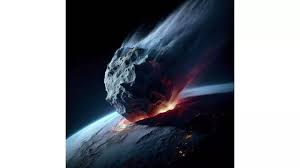Introduction
In the vast expanse of our solar system, a celestial marvel is making its way towards Earth, captivating astronomers and stargazers alike. This awe-inspiring phenomenon is none other than the colossal comet, 12P/Pons-Brooks. What sets this celestial visitor apart are its distinctive "horns," which remain visible even after experiencing its second major eruption in just four months. But there's an even more astonishing secret that this massive comet carries—a real, active volcano, perched atop it. With a size comparable to that of a city, this comet harbors a volcano set to erupt once more, creating a stunning cloud of gas and ice that appears as a pair of horns protruding from the asteroid's surface.
 |
| A Massive Comet with 'Horns' and Active Volcano Approaches Earth |
The Cryovolcanic Wonder
Unveiling the Comet's Core
12P/Pons-Brooks, a fascinating cryovolcanic comet, is the centerpiece of this celestial spectacle. Its core measures about 30 kilometers in diameter and comprises a unique combination of gas, dust, and ice, collectively referred to as "cryomagma."
The Enigmatic Coma
The comet's nucleus is enveloped by a shroud of gas known as a "coma." As the nucleus heats up, it struggles to contain the rising temperature, leading to explosive eruptions into the void of space. The result is the development of those remarkable "horns" that make this comet so exceptional.
A Resemblance to Fiction
Experts have noticed that the comet's irregular shape looks a lot like spaceships from science fiction, like the Millennium Falcon in Star Wars. This has excited space fans and science fiction lovers.
 |
| A Massive Comet with 'Horns' and Active Volcano Approaches Earth |
The Ongoing Transformation
Expanding Coma
As the comet continues its journey sunward, its coma is expected to expand further, accentuating the already remarkable "horns." The peculiar shape of the coma is attributed to anomalies within the comet's nucleus, prolonging the expansion of gases and shaping its irregular form.
Expert Insights
A famous astronomer, Richard Miles, who is part of the British Academy of Astronomy, says that the odd shape of the comet happens because gases inside the comet keep expanding for a long time. This has made scientists and regular people who love looking at the stars really interested in the comet.
The Celestial Showdown
Comet 12P/Pons-Brooks is currently advancing towards the inner regions of our solar system. Its trajectory will ultimately slingshot it toward the Sun, promising an extraordinary celestial event that will captivate Earth's residents on April 21, 2024, before propelling the comet back toward the outer reaches of the solar system. Notably, this comet will not return until 2095.
FAQs
1. What is a cryovolcanic comet?
A cryovolcanic comet, like 12P/Pons-Brooks, is one that erupts with a combination of gas, dust, and ice, rather than molten rock. These "cold volcanoes" create unique features in space.
2. What causes the comet's "horns" to be visible even after eruptions?
The "horns" on the comet remain visible due to the expansion of its coma, caused by the release of gases from its nucleus as it heats up.
3. Is there a specific reason for the irregular shape of the comet?
The irregular shape of the comet's coma is attributed to anomalies within the comet's nucleus, resulting from the prolonged expansion of gases.
4. When can we witness this celestial phenomenon?
The spectacular show presented by comet 12P/Pons-Brooks will captivate Earth's residents on April 21, 2024, as it journeys sunward.
5. When will comet 12P/Pons-Brooks return?
This extraordinary comet is not expected to return until 2095, leaving space enthusiasts eagerly awaiting its reappearance.
Conclusion
In the vast canvas of the cosmos, the arrival of a massive comet with "horns" and an active volcano is a mesmerizing spectacle.
As it journeys towards the Sun, its expanding coma and distinctive features continue to baffle and amaze astronomers and space enthusiasts. The anticipation of its return in 2095 leaves us with a sense of wonder and excitement.



0 Comments